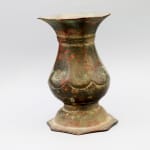Bronze Seljuk Vase, Twelfth Century AD
Bronze
13.5 x 9.4 cm
5 1/4 x 3 3/4 in
5 1/4 x 3 3/4 in
CC.43
Further images
-
(View a larger image of thumbnail 1
)

-
(View a larger image of thumbnail 2
)

-
(View a larger image of thumbnail 3
)

-
(View a larger image of thumbnail 4
)

-
(View a larger image of thumbnail 5
)

-
(View a larger image of thumbnail 6
)

-
(View a larger image of thumbnail 7
)

-
(View a larger image of thumbnail 8
)

-
(View a larger image of thumbnail 9
)

-
(View a larger image of thumbnail 10
)

-
(View a larger image of thumbnail 11
)

This octagonal bronze vase dates from the time of the Seljuks, a high mediaeval Turco-Persian people who, at their height in the AD 1090s, dominated an area from the Levantine...
This octagonal bronze vase dates from the time of the Seljuks, a high mediaeval Turco-Persian people who, at their height in the AD 1090s, dominated an area from the Levantine coast to Afghanistan and India. The Empire was founded in AD 1034 by Tughril, who ruled alongside his brother Chaghri and uncle Musa Yabghu. But the time of the Seljuks was to be brief; by the Twelfth Century AD, the Empire was in decline, and was supplanted by the Khwarazmian Empire in AD 1194. This brief period of dominance, however, accompanied an artistic flourishing, especially in metalwork and in a form of pottery known as mina’i-bowls.
The vase has an octagonal flared rim, leading down to a pyriform body and a high applied foot. The body is decorated with petal-shaped panels, within which are roundels containing alternately a quatrefoil decoration and an interlocking pattern. Below the panels is a pattern of small incised lines. The neck of the vase is decorated with a raised band with an incised pseudo-calligraphic decoration; the base and rim have an incised geometric decoration. The vase suffers from small chips out of the rim, and some dents on the body. The piece has an attractive green patina.
This vase is of the Persian style. The Seljuks, across the course of the Twelfth Century AD, gradually disowned their Turkic roots, and adopted increasingly Persian forms of artistic representation and of language. This persification of Seljuk culture resulted in the adoption of Classical Islamic forms, in which the Seljuks grew to excel.
The vase has an octagonal flared rim, leading down to a pyriform body and a high applied foot. The body is decorated with petal-shaped panels, within which are roundels containing alternately a quatrefoil decoration and an interlocking pattern. Below the panels is a pattern of small incised lines. The neck of the vase is decorated with a raised band with an incised pseudo-calligraphic decoration; the base and rim have an incised geometric decoration. The vase suffers from small chips out of the rim, and some dents on the body. The piece has an attractive green patina.
This vase is of the Persian style. The Seljuks, across the course of the Twelfth Century AD, gradually disowned their Turkic roots, and adopted increasingly Persian forms of artistic representation and of language. This persification of Seljuk culture resulted in the adoption of Classical Islamic forms, in which the Seljuks grew to excel.










